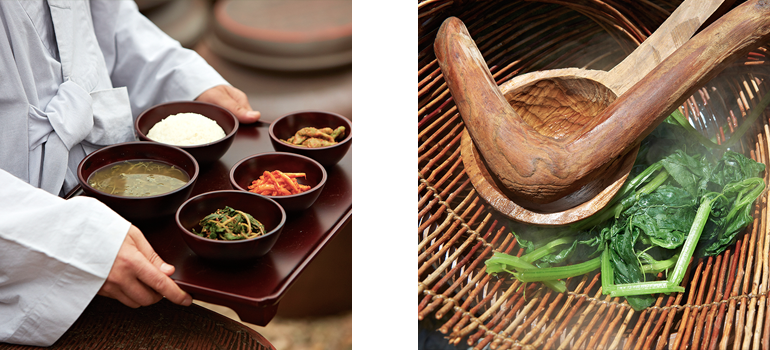Korean Temple Food
Characteristics of Korean Temple Food

Food As Practice
Korean temple food does not use any animal products except dairy products. Korean
Buddhism forbids meat. The Buddha said in the Nirvana Sutra, “Eating meat extinguishes the seeds
of compassion.” Buddhism teaches that compassion means to embrace all living beings as oneself.
The dietary culture of Korean Buddhism has always held reverence for life.
Korean temple food has also traditionally meant that monks and nuns do not use five
pungent vegetables (onions, garlic, chives,green onions and leeks),
these are called the "o-shin-chae", because they hinder spiritual practice.
The prohibition of the five pungent vegetables is a preventive
measure to guard Buddhist practitioners from possible distractions during meditation.
In addition, the prohibition is also meant to prevent any attachment to the flavor of strong spices,
which may also disturb practice.
These characteristics of temple food show how monastic meals are a means through
which Buddhist monks and nuns realize the interdependence of all lives and that they
must strive to establish a world in which all live together in harmony.

Natural Food
Instead of artificial flavors, Korean temple food uses a variety
of mountain herbs and wild greens,
which has led to the development of a vegetarian tradition.
As most Korean temples are located in the mountains,
providing easy access to wild roots,
stems, leaves, fruits and flowers, monks and nuns have naturally become
leaders in shaping vegetarian culture.
Also, natural seasonings and flavor enhancers have been developed.
Examples of common natural seasonings used in temples are
: mushroom powder, kelp powder, jae-pi powder,
perilla seed powder, and uncooked bean powder.
These seasonings are used when making soup stock,
kimchi and vegetable dishes,
correcting nutritional imbalance and enhancing flavors.
Having been used in temples since ancient times, these natural
seasonings are emerging in modern times as a powerful alternative
to artificial flavorings which may be harmful to one’s health.


Fermented Food
A variety of fermented food is made at Korean Buddhist temples.
If cheese, yogurt and wine are typical fermented food in the West,
those in Korea are kimchi, soy sauce, soybean paste,
red pepper paste, vinegar, rice punch, and pine needle tea.
The various nutritive elements produced
through fermentation not only add a savory flavor
to the food but also lower the level of cholesterol,
have cancer-inhibiting qualities,
and guard the human body from many age-related illnesses.


Preserved Food
Korea has four distinct seasons, and all kinds of vegetables and plants are available beginning in the spring.
To keep these vegetables and plants for the winter, monks and nuns developed various techniques for food preservation.
Besides the well-known kimchi and jang, other preserved foods include: jang-a-jji, vegetables preserved in soy sauce,
red pepper paste and soybean paste; vegetables pickled in vinegar and salt; and vegetables preserved in salt.
The advantage of these preserved foods is that they can be stored
for long periods of time with no loss of nutritional value.
They also supply nutrients that may be lacking in vegetables
Eco-Friendly Health Food
The assorted vegetables and greens used in temple
food contain abundant natural fiber as well as carbohydrates and protein.
Korean temple food is rich in various nutrients but low in cholesterol.
Although strictly vegetarian, temple food lacks nothing in nutrition.
It is advisable for anyone to use any or all of the ingredients of temple cuisine
in everyday life for healthier lives and to prevent age-related health problems.
The popularization of temple food would contribute to a healthier
dietary life for Koreans as well as global citizens.




